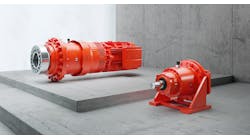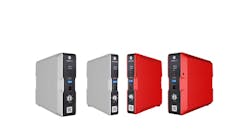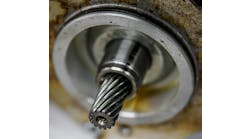In 1906, the International Electrotechnical Commission (IEC) was officially formed to study the international standardization of electrical nomenclature and ratings and symbols. IEC is responsible for the creation of the Système International d'Unités (SI), the system of units such as the meter for length, the second for time and the Ampere for current. In the 1920s, IEC began the process of creating standard performance criteria for electric and electronic systems and services, according to Morand Fachot, communications officer at IEC.
In 1926, the National Electrical Manufacturers Association (NEMA) was formed to address a broad range of problems within the electrical manufacturing industry in the United States. One of the issues the trade organization worked to address was the lack of standardization. Products such as motors, contactors and other devices built by one company could not be easily replaced with a like product from another manufacturer. NEMA has created a vast number of manufacturing and sizing standards that have been adopted by industry.
Though similar, the two groups have different philosophies. NEMA favors robust design and a wider range of applications, where IEC focuses on specific applications and performance. To properly size a NEMA-style full-voltage, across-the-line motor starter, the only information required is the motor horsepower and voltage. Sizing an IEC starter of the same type requires knowing the motor load, the duty cycle and full load current.
NEMA standards list 10 sizes to cover 2-hp to 900-hp motors. IEC standards specify 20 sizes to cover the same range of motors. Additionally, IEC defines more than 30 utilization categories for the contactor part of a motor starter in IEC 947. For most industrial applications, IEC motor selection falls into two categories:
- AC-3 for squirrel cage motors. Opening of the contacts occurs while the motor is running and current draw is full-load amperage (FLA). Starting inrush current is five to eight times nominal current.
- AC-4 for squirrel cage motors. Opening and closing of the contacts can occur with the motor under inrush current, or five to eight times FLA. Starting under full load and forward/reverse jogging allowed.
Because IEC motor starters are more precisely matched to the control application, below 100 FLA, they are typically smaller than a NEMA starter sized for the same function. NEMA-style starters are designed to be more general purpose and robust than their IEC counterparts. The advantage of this robustness is evident when the motor is called upon to perform under conditions not foreseen at the time of design. The disadvantages of this robustness translate into a higher initial cost, larger size and often underused capacity for the NEMA style device.
IEC style starters are typically made up of an interconnected contactor and overload device. Serviceability is not a design consideration. When a component of the IEC starter fails, the contactor or the overload is simply replaced. Most lower to mid-power IEC motor starters often include DIN-rail mounting for ease of mounting. NEMA style starters often allow access to internal components such as the coil, contacts and overload heater elements. These parts are serviceable without removing the motor starter from the enclosure.
An overload relay is always part of the motor-starter circuit. The overload interrupts the current flow into the contactor’s coil when the current draw of the motor exceeds the overload’s rating for a specific amount of time. Overloads belong to one of four classes: 10, 20, 30 and 40. The numeric part of the class is that maximum amount of time, in seconds, that excess current can flow to the motor before the relay operates and de-energizes the motor-starter coil.
The simplest type of motor-starter overload is the thermal overload relay. Current passing from line voltage, through the contactor, is routed through a resistive element before being applied to the motor. As the current increases, the resistive element heats up. When the current flow is greater than the rating of the overload, the heat generated by the resistive element warps a bi-metallic spring causing the overload relay contacts to open, thus de-energizing the contactor coil. The heater elements are available in different values, so the motor overload circuit may be adjusted per the requirements of the specific application. This type of overload protection is simple and dependable. However, the accuracy of such a design is dependent upon the manufacturing tolerances of the resistive element and the bi-metallic spring. Changes in the line voltage also alter the accuracy of such a device. Some NEMA style starters, particularly factory-assembled models, incorporate this type of thermal overload protection.
ALSO READ: Soft starters bring motors up to speed in a controlled fashion
IEC style starters and some NEMA style starters, as well, are built in a modular fashion. The contactor part and the overload part of the unit are separate and must be assembled. Often, IEC starters that use thermal overloads have an adjustment feature. The adjustment range is usually ±10% or 15% from the rated current. IEC adjustable thermal overload relays employ a mechanical adjustment device that changes the relative position of the bi-metallic spring and the heater or by changing the spring preload tension.
A second method of overload protection is available for modular style units. An electronic overload module uses current transformers to measure the current supplied to the motor. An electronic overload relay is more accurate than a thermal relay and provides detection of phase loss, phase imbalance, ground faults and wider adjustment range. Electronic overloads used in conjunction with a fieldbus module permit communication and monitoring abilities.
Electronic overloads are considerably more expensive than simpler thermal overload. They are also much more complicated with more modes of failure.
In general, NEMA-style motor starters are robust in design, larger and more costly than IEC starters of the same current rating. NEMA standards are more popular in North America than those from IEC. IEC-style starters are more application-specific and are smaller and less costly than NEMA-style. IEC devices are more popular worldwide than NEMA.
Selecting a motor-starter style for a new design depends on how much application information is available at design time. It can also depend on local or industry practice, budgetary concerns and available panel space. When replacing a failed existing motor starter, most advice suggests replacing it with the same style.




